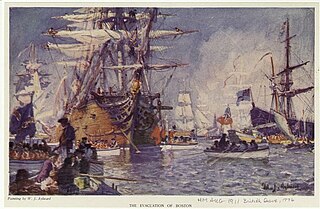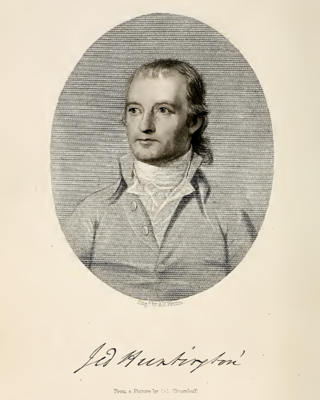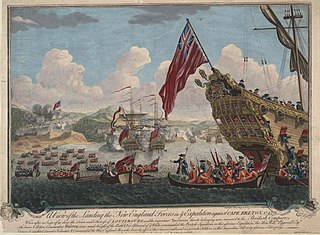
The Continental Army was the army of the United Colonies representing the Thirteen Colonies and later the United States during the American Revolutionary War. It was formed on June 14, 1775 by a resolution passed by the Second Continental Congress, meeting in Philadelphia after the war's outbreak. The Continental Army was created to coordinate military efforts of the colonies in the war against the British, who sought to maintain control over the American colonies. General George Washington was appointed commander-in-chief of the Continental Army and maintained this position throughout the war.

The siege of Boston was the opening phase of the American Revolutionary War. In the siege, American patriot militia led by newly-installed Continental Army commander George Washington prevented the British Army, which was garrisoned in Boston, from moving by land. Both sides faced resource, supply, and personnel challenges during the siege. British resupply and reinforcement was limited to sea access, which was impeded by American vessels. The British ultimately abandoned Boston after eleven months, moving their troops and equipment north, to Nova Scotia.
The 5th Connecticut Regiment was raised on April 27, 1775, at Danbury, Connecticut, under the command of David Waterbury. The Regiment was one of six formed by the Connecticut Legislature in response to the hostilities at Lexington and Concord, Massachusetts. The Fifth would see its first action during the Invasion of Canada. As was the practice during the first few years of the war, the New England troops were engaged only until year's end and the original Fifth Connecticut Regiment was disbanded on December 13, 1775. It would not see National service during 1776, but a State Regiment, organized by Colonel Philip Burr Bradley, did serve in the New York and New Jersey campaign. The Fifth returned to Continental duty at the beginning of 1777. The Regiment went on to fight at the Battle of Ridgefield, Battle of Germantown and the Battle of Monmouth. The Regiment was merged along with the 7th Conn. into the 2nd Conn. on January 1, 1781. The Fifth was furloughed June 15, 1783, at West Point, New York and disbanded on November 15, 1783.

In October 1774, Jedediah Huntington of Norwich was made Colonel of the 20th Regiment of Connecticut Militia. When news of the Battles of Lexington and Concord arrived in Norwich on April 20, 1775 Colonel Huntington immediately got his men ready to march. On April 26 they arrived in Wrentham, Massachusetts, and a few days later they were in Roxbury and became part of the Siege of Boston. Because of a lack of overall command, as well as a lack of supplies, many of the militia units returned home.

The 2nd Canadian Regiment (1776–1783), also known as Congress' Own or Hazen's Regiment, was authorized on January 20, 1776, as an Extra Continental regiment and raised in the province of Quebec for service with the American Continental Army under the command of Colonel Moses Hazen. All or part of the regiment saw action at Staten Island, Brandywine, Germantown and the Siege of Yorktown. Most of its non-combat time was spent in and around New York City as part of the forces monitoring the British forces occupying that city. The regiment was disbanded on November 15, 1783, at West Point, New York.

The Connecticut Line was a formation within the Continental Army. The term "Connecticut Line" referred to the quota of numbered infantry regiments assigned to Connecticut at various times by the Continental Congress, the size of its allocation determined by the size of its population relative to that of other states. These, together with similarly apportioned contingents from the other twelve states, formed the Continental Line. The concept was particularly important in relation to the promotion of commissioned officers. Officers of the Continental Army below the rank of brigadier general were ordinarily ineligible for promotion except in the line of their own state.

The New Hampshire Line was a formation in the Continental Army. The term "New Hampshire Line" referred to the quota of numbered infantry regiments assigned to New Hampshire at various times by the Continental Congress. These, along with similar contingents from the other twelve states, formed the Continental Line. For the promotion of senior officials, this concept is particularly important. Officers of the Continental Army below the rank of brigadier general were ordinarily ineligible for promotion except in the line of their own state.

The Rhode Island Line was a formation within the Continental Army. The term "Rhode Island Line" referred to the quota of numbered infantry regiments assigned to Rhode Island at various times by the Continental Congress. These, together with similar contingents from the other twelve states, formed the Continental Line. The concept was particularly important in relation to the promotion of commissioned officers. Officers of the Continental Army below the rank of brigadier general were ordinarily ineligible for promotion except in the line of their own state.
The 1st Connecticut Regiment (1775) was raised on 27 April 1775 at Norwich, Connecticut in the Connecticut State Troops. The regiment consisted of ten companies of volunteers from New Haven and Litchfield counties of the state of Connecticut.
Benjamin Hinman was a surveyor, soldier and legislator.

Jedediah Huntington, was an American general in the Continental Army during the American Revolutionary War. After the war, he served in numerous civilian posts.

The siege of Louisbourg took place in 1745 when a New England colonial force aided by a British fleet captured Louisbourg, the capital of the French province of Île-Royale during the War of the Austrian Succession, known as King George's War in the British colonies.
The Battle of Ridgefield was a series of American Revolutionary War skirmishes in Danbury, Connecticut and Ridgefield, Connecticut.
Captain Richard Douglass (1746–1828) was an American cooper, soldier, deacon, and a politician. He was born in New London, Connecticut, in 1746 and was the son of Stephen and Patience Douglass. He ran a successful business as a cooper. In 1760, there were already more than 40 ships from brigs to sloops registered in New London. Many of them were under the Shaw Family flag conducting business in the East and West Indies, as well as foreign ports in Lisbon, Barcelona, Amsterdam, England and Russia. Coopering was a valuable trade, especially with New London and the Colonies' increasing demand for Bajan (Barbados) rum.

American colonial marines were various naval infantry units which served during the Revolutionary War on the Patriot side. After the conflict broke out in 1775, nine of the rebelling Thirteen Colonies established state navies to carry out naval operations. Accordingly, several marine units were raised to serve as an infantry component aboard the ships of these navies. The marines, along with the navies they served in, were intended initially as a stopgap measure to provide the Patriots with naval capabilities before the Continental Navy reached a significant level of strength. After its establishment, state navies, and the marines serving in them, participated in several operations alongside the Continental Navy and its marines.
Lieutenant-General Sir James Frederick Lyon was a distinguished officer of the British Army who served as Governor of Barbados from 1829 to 1833.
Thomas Fitch V was a member of the Connecticut House of Representatives from Norwalk in the sessions of October 1761, May and October 1763, May and October 1764, May and October 1765, May and October 1766, May 1767, October 1768, May and October 1769, October 1770, October 1771, October 1772, October 1773, October 1775, and May 1776.





